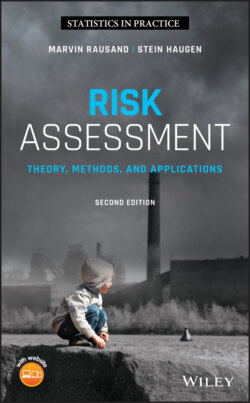Читать книгу Risk Assessment - Marvin Rausand - Страница 252
5.3.1.1 Cost–Benefit Assessment
ОглавлениеALARP implies that a cost–benefit approach can be adopted to decide what constitutes a “practicable” level of risk. In the ALARP region, the notion grossly disproportionate is central. It requires that a risk reduction measure be implemented if the cost of the measure is not grossly disproportionate to the benefit gained. A disproportion factor may be calculated as
(5.2)
The cost of the risk reduction measure is an estimate of the total cost, which covers not only purchase, installation, and training but also cost implications related to the operation of the system, such as reduced productivity. If reduced productivity has a strong influence on a decision not to implement, the company should show that phasing or scheduling the work to coincide with planned downtimes (e.g. for maintenance) would not change the balance. In the cost estimation, it is common to take a societal view on the costs. For a company, cost associated with accidents can often (at least partially) be covered by insurance. There may also be other effects that reduce the net cost. For society at large, this is not relevant, because insurance is just a redistribution of the costs on many instead of just one.
The benefit of implementing a risk reduction measure is an estimate of the “cost” reduction implied by fewer injuries and fatalities (expressed through VSL) and also of possibly reduced input resources and/or improved system productivity.
The evaluation of disproportionality is carried out by first defining a disproportionality limit . If the actual factor as calculated by (5.2) is less than , the risk reduction measure should be implemented, and if , it should not be implemented. A disproportionality limit of, for example, means that for a measure to be rejected, the costs should be more than three times larger than the benefits. There are no strict authoritative requirements on what limit to employ, but it is reasonable to use a higher value of for high risk (i.e. close to the upper limit) than for lower risk (HSE 2001).
A challenge with the cost–benefit approach is that it raises the problem of expressing not only the costs but also the risk reduction benefits in monetary terms. This is a particularly sensitive issue when it comes to putting a value on human life as was discussed earlier. To guide decision‐making, some companies use internal criteria for the value of human life. An alternative to such explicit valuation of human life is simply to calculate the cost–benefit ratio for any risk reduction measure and to look out for any clearly unreasonable situations. If the value of life is not quantified, then resources, which also have value, cannot be allocated rationally to develop and implement countermeasures to protect life. For other types of consequences, such as environmental damage, costs also need to be calculated. Clean‐up costs are sometimes used in connection with spills, but these costs do not reflect irreversible damage to species affected by spills.
A particular problem when a comparison of cost and benefit is done in this way is that the costs are deterministic, whereas the benefits are probabilistic. If we decide to implement a risk reduction measure, we know that there will be a cost associated with it. The benefit we gain is a reduction in the probability of an accident occurring or a reduction in the consequences, should an accident occur. Often, the probability of an accident is very low – regardless of whether individual risk measures are introduced or not – such that the accident will not occur even if the risk measure is not introduced. The benefit is thus purely probabilistic.
Another aspect of cost–benefit assessment is the use of discounting of costs and benefits. In financial calculations, this is common to do and implies that future costs and benefits have a lower value than costs and benefits that we get today. In cost–benefit assessment, this is used sometimes, but not always. There are arguments both for and against using this approach, but perhaps the foremost argument can be tied to the occurrence of accidents now versus in the future. If we have a hypothetical situation, where we know that an accident will occur, but we can choose whether it will occur one year from now or 10 years from now, everyone would undoubtedly choose the latter option. In this respect, we can say that future accidents have a lower “cost” than accidents today and that future risk therefore should be discounted.
To summarize, the ALARP principle states that money must be spent to reduce risk until it is reasonably low and must continue to be spent for as long as the cost of doing so is not “grossly disproportionate” and the risk is not negligible. If a “tolerable” level of risk can be reduced further at a reasonable cost and with little effort, it should be. At the same time, the ALARP principle recognizes that not all risk can be eliminated. Because it may not be practicable to take further action to reduce the risk or to identify the accidents that pose the risk, there will always be some residual risk of accidents.
